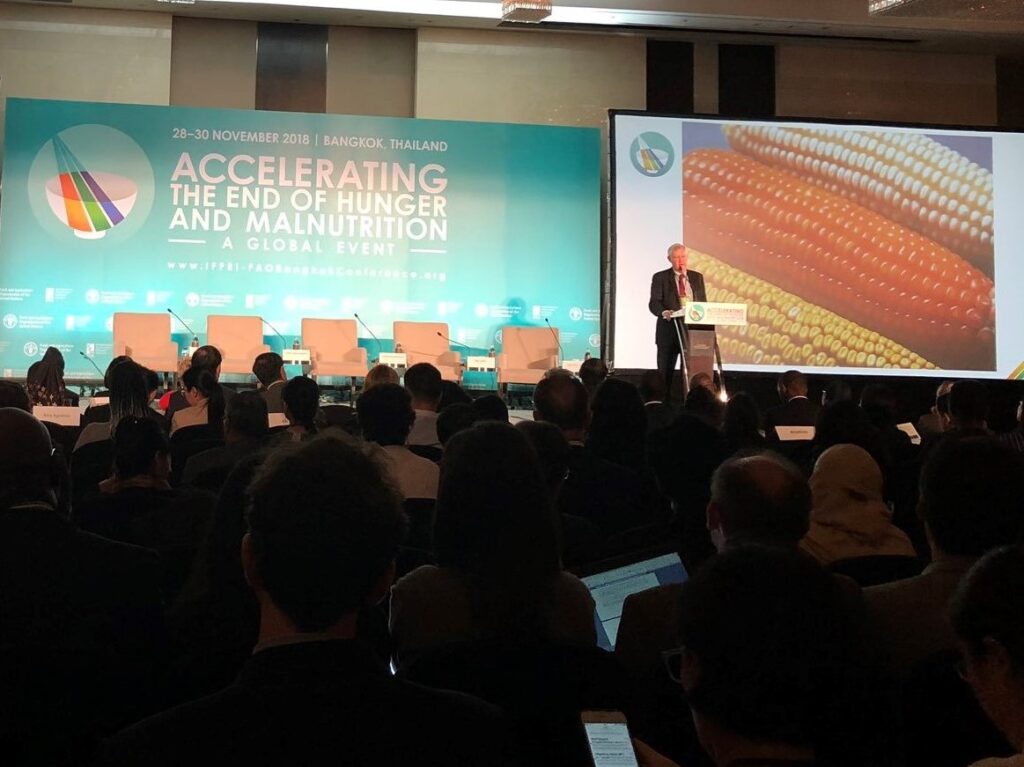“Despite progress over the last three decades, there is an urgent need to pick up the pace to end malnutrition and hunger by 2030.”
The speaker was Shenggen Fan, Director-General of the International Food Policy Research Institute (IFPRI), who did not mince words in his opening address at the conference on Accelerating the End of Hunger and Malnutrition in Bangkok, Thailand, which took place from November 28–30, 2018.
The conference, hosted by IFPRI and the Food and Agricultural Organization of the United Nations (FAO), was intended to focus attention on “policies, interventions and innovations that can overcome barriers and speed progress” toward achieving the 2030 Sustainable Development Goals.
Echoing Fan’s message, the 2018 Global Nutrition Report launched at the conference argues that despite ever-increasing knowledge about the causes and solutions, progress is slow and there needs to be an increased focus on making healthy diets affordable, accessible, and desirable to end malnutrition.
The decision makers, practitioners, and researchers attending the conference reviewed successes, challenges, and lessons learned, and identified promising opportunities. Speakers highlighted country strategies supporting household reductions of poverty and hunger; policies, programs and institutions that leverage evidence-based nutrition successes; and emerging technologies that can scale progress sustainably.
Attention was also paid to the context in which such advances must occur: Climate change is exacerbating conflicts and threatening plant and animal health. Food systems are urbanizing. Obesity and noncommunicable diseases are becoming more prevalent than undernutrition. What’s more, progress has historically left behind groups most affected by hunger and malnutrition.
A key message at the conference was that change for the better requires partnership, and technological and policy innovations. Biofortification—a climate-smart technological innovation that targets the most vulnerable populations—was highlighted at the conference in several sessions.
In his keynote address, Howdy Bouis, the founder and interim CEO of HarvestPlus, explained why biofortification is a practical option for addressing nutritional gaps among vulnerable populations. Price increases for vegetables and other nutritious non-staples have far outpaced those for rice, wheat, and other staples in recent decades. In effect, nutritious non-staple foods remain out of reach for billions of people.
“Calories are getting more and more affordable, but the minerals and vitamins are getting more and more expensive over time,” said Bouis.
“Providing dietary quality to the poor is getting harder and harder and harder,” because of the rise of non-staple food prices following the Green Revolution, said Bouis. “So, this is our challenge: how do we reverse these [price] increases?”
His keynote on innovations to address hunger and malnutrition illustrated how the process of breeding nutrient-rich staple crops can provide immediate help.
“We need to get agriculture to produce a much higher percentage of the minerals and vitamins we need. It’s much more cost-efficient; it’s much more sustainable,” he said.
Innovation is not as simple as having a compelling idea, Bouis cautioned, recounting the ten years it took to convince others of the promise of biofortification before the work truly began to implement it. “You need excitement, you need passion, you need an idea, but it takes a long time; you need the perseverance as well.”
Bouis is not shy about his ambitions for biofortification. Reflecting on the vitamin A-biofortified orange maize that HarvestPlus has developed and promoted in Africa, he said: “My hope is that 20 years from now, most of the maize in Africa is orange and the children will have forgotten that there used to be white maize.”
In this UN Decade of Action on Nutrition, the scaling of successful, innovative and multisectoral activities—like biofortification—will allow billions of women and children to reach their potential.
